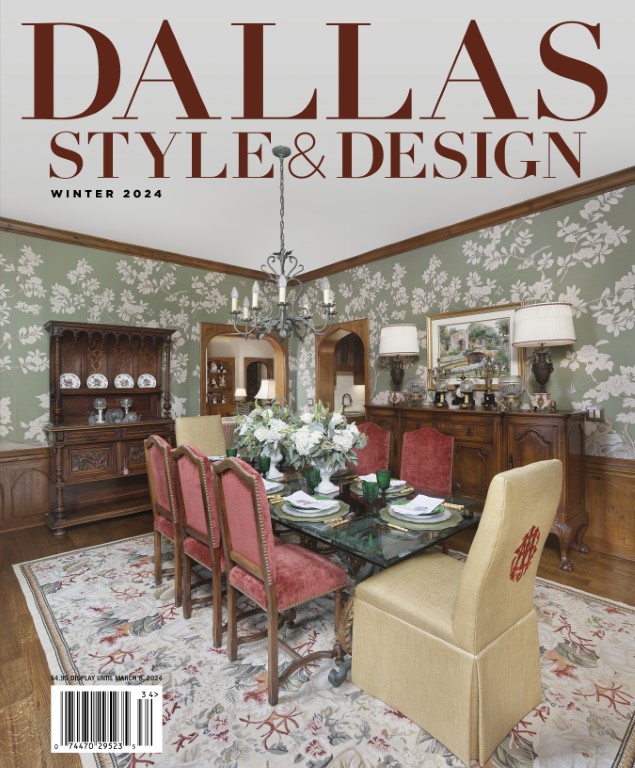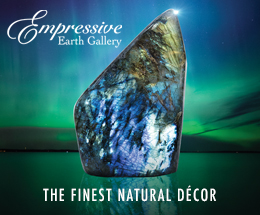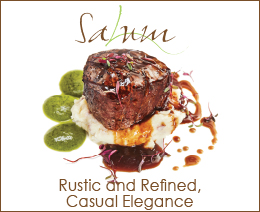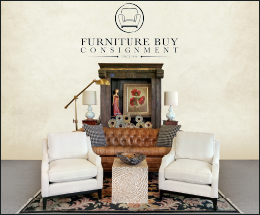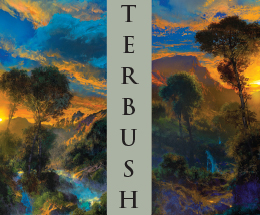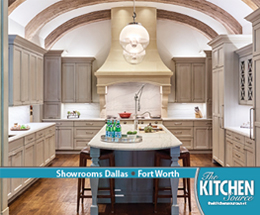LEAVING HER IMPRINT THROUGH PRINTMAKING

When artist Kat LiBretto noticed the destructive force that real estate development was having on natural landscapes around her, she was inspired to create prints that, she says, “aim to provide my audience with a broad range of topics, offering personal interpretations of environmental themes.”
Fueled by her interest in the natural landscape and a desire to experience America’s most natural environments, The National Parks, coupled with the theme of coexistence of humans in these places and their impact on the environment, LiBretto creates stunning prints that capture serene moments of untouched landscapes. Her compositions depict recognizable landmarks, but the artist injects imagined elements. LiBretto explains that it’s “so that the viewer may connect and engage with the work, and each piece allows for many different interpretations.”
LiBretto researches and documents specific locations before she begins a print. Back in her studio, she conceives the composition, illustrates her vision and prepares the individual screens, then prints every piece.
Creating up to eight original prints a year, LiBretto creates work depicting the skylines of Dallas, London and New York as well as dreamlike visions of cloud-filled skies at dusk in the desert, mountains and dark, alluring forests. The artist’s latest prints also include pristine skies scarred by contrails from jets.
Not one to be confined or limited to old methods, LiBretto experiments with various screen printing methods in her work.

“The technique I use is similar to that of a painter in a studio— working with a variety of materials, manipulating the flat surface of paper, adding illusion and texture and areas of depth and complexity in multiple layers, colors and application,” LiBretto says.
Each color and layer of illustration in her prints undergoes an experimental approach to the traditional process and materials, which includes UV-sensitive emulsion, mesh screens, stencils, inks and squeegees.
LiBretto’s work has received numerous awards and is exhibited in galleries and private collections around the world, regularly in London and Hong Kong. She received a master’s degree with merit in printmaking at Camberwell College of Arts/University of the Arts London.
While mankind may be leaving its imprint on the Earth, LiBretto is certainly creating her own imprints and capturing environments in their natural state. katlibretto.com

EVERYTHING’S BIGGER IN TEXAS
Books about architecture usually come in two forms: Either they are long on text about theory or they are filled with plans and photographs with very little explanation. Then along comes a graciously appointed book, A Vision of Place (Texas A&M University Press, $50), that reflects on more than two decades of practice by two Texas-based architects, William Curtis and Russell Windham, and provides the perfect balance of imagery and text.
Eighteen projects from the Curtis & Windham Architects firm are showcased, ranging from a small backyard garage- studio in an unassuming neighborhood to large dwellings situated in Houston’s River Oaks.
The work of Curtis & Windham demonstrates the versatility of classical ideals and methods for instilling a contemporary resonance of place in urban, suburban and even rural contexts.
 STYLISH SMALL STUFF
STYLISH SMALL STUFF
They say it’s the little things in life that matter most. If that’s the case then Susanna Salk’s latest decorating tome, It’s the Little Things (Rizzoli, $45), should be on every interior designer’s bookshelf. This little book is filled with big ideas and quotes from some of the world’s best designers to go along with the over 200 stunning full-page photographs.
What sets It’s the Little Things apart from other interior design books is its intense focus on the minute details of room décor. Salk’s theme is that it is the personal items, placed on consoles, bookshelves, mantels and throughout a home, which create spaces that reflect a homeowner’s personality.
It’s all in the details, and it’s the details that make this book such a prize jewel.
 CLASS IS IN
CLASS IS IN
Continuing our design education, Carl Dellatore has edited together “100 lessons from America’s finest designers on the art of decoration” in Interior Design Master Class (Rizzoli, $50). This massive coffee-table book brings together 100 essays written by interior designers on topics such as design theory, structure, style, process, elements and inspiration, all paired with gorgeous photos of their work that illustrate the principles being discussed.
If years of experience and knowledge can be collected in one place, this book has successfully accomplished the task. As the title implies, this book is like a master class in interior design and will reinforce the theories you already have about your work as well as open you to new ideas.
STAMP, SKETCH, STYLE, STAMP, SKETCH, STYLE
Art and design are found everywhere. Art is relative, but the more you open yourself up to it, the more you recognize it in every aspect of life.
This is part of the message New York-based creative director and founder of Pattern Pulp Studio Shayna Kulik promotes in her new book, Pattern Studio (Chronicle Books, $18.95). Filled with 50 exercises for creating original patterns, this workbook provides inspiration, direction and space to stretch your own artistic muscles to create designs for use on textiles, wall coverings, fashion and more.
Each spread provides a short paragraph of directions to get you started on your design and plenty of room to create. The book does not limit you to the space within the binding, but starts you on your journey as a patternmaker in the world at large.
Closing the book are 50 additional inspiration pages filled with art from working professionals in patternmaking, demonstrating a range of styles and techniques. Each artist shares insights into their approach to patternmaking, which is as helpful as the many exercises.
Considering the trend in adult coloring books, this workbook is timely and dovetails perfectly for those who want to go beyond predefined designs and start creating their own.
If you ever thought that art was something you might like to try, or if you are a working design professional wishing to expand your creative palette, this book is a fine starting point for exploring the world of patterns and repetitive sketching to launch a new dimension in your craft. Pick up a copy and start stamping, sketching and styling.
BIG TIME BIG BAND
Frank Sinatra, Dean Martin, Sammy Davis Jr. These are the generals of The Great American Songbook and big band music. Decades later, Harry Connick Jr. and Michael Bublé have been added to this list. Dallas native Hunter Sullivan is planning to have his name added to the pantheon of these legendary singers as well.
Twenty years of singing and playing music has provided Sullivan a life many can only dream of. He performs between 75 to 100 shows a year and has traveled through Europe and Asia, and played gigs in New York, Las Vegas and Hollywood— where he performed for an audience of such well-known celebrities as Jack Nicholson, Warren Beatty, and many other A-listers. “It was surreal to play the Hollywood gigs and see the room filled with celebrities watching us,” says Sullivan.
Not bad for a musician who was not classically trained and who taught himself to play drums, guitar and piano.
Sullivan’s big band, which includes 10 horn players, performs nationally and around Dallas at many special events and charity functions, including for the Crystal Charity and the Junior League. The band has also played the Sundance Square New Year’s Eve festivities and the Dallas Arboretum concert series over the past few years. “My big band is more of a Count Basie-style band. We do an eclectic mix of pre-Beatles pop with a little of a Vegas flavor, but this is not a parody or joke. It is a very deep and rich tradition that we take seriously. Our songbook covers late ’50s to early ’60s Bobby Darin, Sinatra and Sammy Davis songs,” the bandleader says.
The 14-piece band comprises about 20 percent of Sullivan’s singing work. He also has a trio that plays twice a month at the Mansion at Turtle Creek. His company secured the contract for all bookings at the Rosewood Hotels property late last year.
“I was a rock ‘n’ roll singer playing gigs in Deep Ellum,” Sullivan says. “I went through a low period where I considered getting out of the biz and going back to school. I started singing at Sipango—the legendary restaurant—and within a short period of time I met my producer, Nick Venet, and we went to Los Angeles.”
In LA Sullivan met Quincy Jones, Steve Blauner and other luminaries, and within 12 weeks Sullivan says, “I went from trying to get out of the business to discovering big band and recording an album.”
In addition to that first record, King for a Day, Sullivan also recorded a live album as a promotion for the Mansion at Turtle Creek as well as various originals with accompanying videos. “I am also always on the lookout for young artists to mentor and hopefully produce for as well,” he says.
The popularity of jazz and big band music is experiencing a swell today thanks in part to the incredible film La La Land, and the performances of bands like Sullivan’s. “We are definitely keeping this genre alive. The music is still appreciated. The music is cross generational, which is cool,” he says.
Cool. That may the best way to describe Sullivan and his bands. huntersullivan.com

